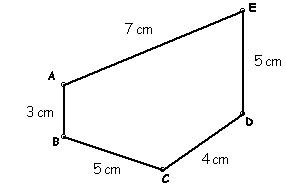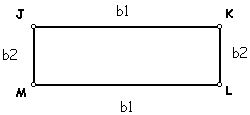Perimeter
of Polygons
The perimeter of a polygon is the measured
distance all the way around the figure. So, in order to find the
perimeter of a polygon, we just add the lengths of each segment that makes
up the figure.
Ex 1) To find the perimeter of polygon
ABCDE, we add the lengths of the sides.

P
= AB + BC + CD + DE + EA
P = 3
+ 5 + 4 + 5 + 7 = 24
The perimeter
of ABCDE is 24 cm.
Ex 2) Consider JKLM
with JK = LM and KM = LJ. For one pair of sides JK = LM = b1,
and for the other pair of sides KM = LJ = b2.

P = JK + KL + LM + MJ
P = b1 + b2 +
b1 + b2
P = 2b1 + 2b2
P = 2(b1 + b2)
**You can use this formula to find the perimeter of any parallelogram.
Now, by substituting L for b1
and W for b2, notice the simplified formula P = 2(L + W).


